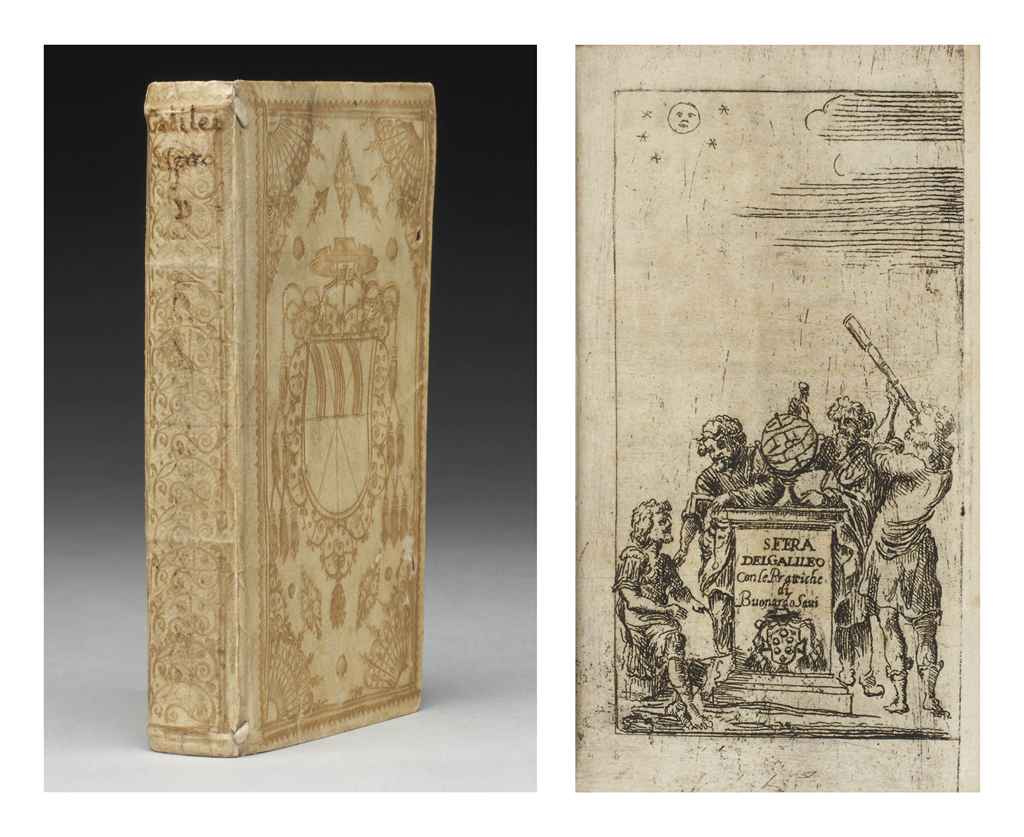GALILEI, Galileo (1564-1642) Istoria e dimostrazioni intorno alle macchie solari e loro accidenti. Rome: Giacomo Mascardi, 1613. First edition of Galileo’s published endorsement of the Copernican model, ‘domestic’ issue, containing the second part, ‘De maculis solaribus tres epistolae,’ with letters written to Marcus Welser by the Jesuit Christoph Scheiner. It is this correspondence, in which Scheiner promotes his theory of sunspots as small planets, that prompted Galileo to publish his account of his own observations. Galileo wrote the Istoria e dimostrazioni in the form of letters to Welser, arguing that sunspots appeared on the surface of the sun and were not tiny satellites of it. Based on observations of their motion, Galileo concluded that the sun rotated on a fixed axis. The work also includes Galileo's first written account of his observations of the phases of Venus and the mysteries of Saturn. His specific endorsement of the Copernican model foreshadowed many of his later theories and their political and religious consequences: ‘I tell you that this planet also, perhaps no less than horned Venus, agrees admirably with the great Copernican system on which propitious winds now universally are seen to blow...’ (Stillman Drake's translation). Two issues were published simultaneously, one with and one without Scheiner's letters, aimed at a domestic or international market, respectively. Since Scheiner was then teaching at Ingolstadt, the printer Mascardi felt free to publish his letters in Italy, but north of the Alps privileges would be infringed. Cinti 43-44; Dawson 2587; Carli and Favaro 60; Riccardi I, 509 (‘Raro’); Stillman Drake, Galileo at Work 198; Waller 12046. Quarto (219 x 157mm). Two parts in one volume, printer's woodcut device on title, engraved portrait of Galileo, 38 full-page engravings of sunspots, 5 full-page engravings of Jovian satellites, one engraving and 8 woodcut and typographic diagrams in text, the second part with one double-page engraving, one large and 3 smaller engravings and 9 woodcut illustrations (title tipped onto A2, small hole in last leaf, small marginal holes in C2-D1, very occasional light browning). 19th-century vellum-backed boards (front joint splitting, rubbed, spine label chipped, few wormholes at spine). Provenance: Cardinal Ioan Maria Gabrieli (18th-century stamps throughout, annotations presumably in his hand, some just shaved) – stamp removed from final leaf.
GALILEI, Galileo (1564-1642) Istoria e dimostrazioni intorno alle macchie solari e loro accidenti. Rome: Giacomo Mascardi, 1613. First edition of Galileo’s published endorsement of the Copernican model, ‘domestic’ issue, containing the second part, ‘De maculis solaribus tres epistolae,’ with letters written to Marcus Welser by the Jesuit Christoph Scheiner. It is this correspondence, in which Scheiner promotes his theory of sunspots as small planets, that prompted Galileo to publish his account of his own observations. Galileo wrote the Istoria e dimostrazioni in the form of letters to Welser, arguing that sunspots appeared on the surface of the sun and were not tiny satellites of it. Based on observations of their motion, Galileo concluded that the sun rotated on a fixed axis. The work also includes Galileo's first written account of his observations of the phases of Venus and the mysteries of Saturn. His specific endorsement of the Copernican model foreshadowed many of his later theories and their political and religious consequences: ‘I tell you that this planet also, perhaps no less than horned Venus, agrees admirably with the great Copernican system on which propitious winds now universally are seen to blow...’ (Stillman Drake's translation). Two issues were published simultaneously, one with and one without Scheiner's letters, aimed at a domestic or international market, respectively. Since Scheiner was then teaching at Ingolstadt, the printer Mascardi felt free to publish his letters in Italy, but north of the Alps privileges would be infringed. Cinti 43-44; Dawson 2587; Carli and Favaro 60; Riccardi I, 509 (‘Raro’); Stillman Drake, Galileo at Work 198; Waller 12046. Quarto (219 x 157mm). Two parts in one volume, printer's woodcut device on title, engraved portrait of Galileo, 38 full-page engravings of sunspots, 5 full-page engravings of Jovian satellites, one engraving and 8 woodcut and typographic diagrams in text, the second part with one double-page engraving, one large and 3 smaller engravings and 9 woodcut illustrations (title tipped onto A2, small hole in last leaf, small marginal holes in C2-D1, very occasional light browning). 19th-century vellum-backed boards (front joint splitting, rubbed, spine label chipped, few wormholes at spine). Provenance: Cardinal Ioan Maria Gabrieli (18th-century stamps throughout, annotations presumably in his hand, some just shaved) – stamp removed from final leaf.
.jpg)

.jpg)

.jpg)
.jpg)





.jpg)



Try LotSearch and its premium features for 7 days - without any costs!
Be notified automatically about new items in upcoming auctions.
Create an alert